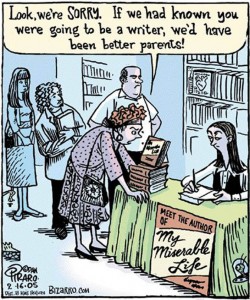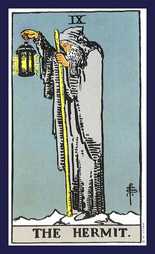Understanding PTSD as a variety of neurodiversity has helped me feel less isolated and medicalized by the “survivor” label. I’m grateful to discover the work of disability activists and theorists who are radically re-imagining a world without rigid norms for how everyone should think and feel.
My recent drift away from organized religion owes at least as much to religion’s assumption of neurotypicality as to any doctrinal mismatches. Because of the great diversity of mind-body types and life experiences, the “universal” religious value-system that brings one person into balance tips another person further off. For instance, a depressed, dissociated person may sink deeper into that condition by following the Buddhist/New Age prescription to dis-identify with your desires and feelings, while the same advice may be a healthy corrective for someone who’s driven by out-of-control cravings. That’s not a problem if you know who you are and what you need. But every religion tends to shore up its authority by assuming that the type of person who is most helped by its prescriptions is the only real or preferable type that exists.
Except for pathologies that harm others, I think we should try to avoid value-judgments about the optimal human personality. In my book, that’s the classical Christian sin of pride that suppresses our empathy and puts us in place of God: “You should be made in my image.” We unconsciously assume that everyone is or should be like ourselves, and so we resist their requested accommodations with the criticism that they are trying to get extra privileges (rather than calling attention to the privileges we already have).
Would it be too hard to preach and teach with more awareness of neurodiversity? Would sermons sound too much like automated phone menus? “If you are self-centered and isolated, come work at our soup kitchen. If you are co-dependent and avoid your problems by doing good works, skip church next week and take your kids to the park. Press one…”
The links I’m highlighting this month are more hopeful that institutions can effectively acknowledge trauma and other kinds of neurodiversity. The hand-wringing over the logistics of accommodation is frequently a proxy for the real insecurity we feel when our personal sense of normalcy is challenged. It’s not pretty to realize that we have been too proud of our competence in an environment that was designed for people like us. Or the resistance may be simply that we worked so hard to stay on the acceptable side of the line–not too fat, old, needy, hysterical, stupid, poor–and now we’re being told that those metrics shouldn’t matter.
The blogger Feminist Aspie’s open letter, “Dear Anyone Who’s Ever Had Their Disability Accommodations Ridiculed…”, responds to Internet mockery of a decision by the National Union of Students (UK) Women’s Conference to request sign-language applause instead of clapping at their events. Sudden loud noises can make these events challenging for people who have sensory processing issues from autism, anxiety, and other conditions. I’m not autistic, but I do have a lot of sensory sensitivities, either from trauma or just how I’m wired. (It pisses me off that I’ll never know which, like there was some normal person I was cheated out of being–internalized ableism again.) The demeaning comments she critiques are ones that I’ve heard and internalized with great shame. Here’s an excerpt, but go read the whole thing. I also recommend her post The Illusion of “Neutral”.
“How do you expect to survive in the real world?”, they might tell you. “You just need to work on your difficulties!” What they don’t know (or wilfully ignore) is that you already are doing that work, more than they could ever know. Society or the “real world” (which, let’s not forget, is a human construct so shouldn’t be accepted as a given) is inaccessible and harmful in a multitude of ways. It is designed to exclude people like us, and even though it often goes un-noticed, you are working your socks off to live and to thrive in it anyway – and again, abled people don’t have to deal with that stuff at all. Most of them genuinely don’t realise this privilege, so it doesn’t occur to them that maybe they could move some of the way towards you. With apologies to Muse, they like to give an inch whilst you give them infinity. It is absolutely not selfish to more evenly distribute some of that load.
To disabled women: I’ve been saddened to see a lot of this ableism and bullying coming from abled feminists, who think that improving accessibility at the NUS Women’s Conference “trivialises feminism” or “makes women look weak”. I’m really sorry about them. I can’t believe this even needs saying, but you are not letting your gender down just by existing. You didn’t create a society which sees women as lesser – men did that. I think feminists really need to work on this ableist (and sexist!) idea that women have to be completely invulnerable, with no concept of emotions or physical or mental health or self-care, just to “earn” the respect that men automatically receive. You’re not trivialising feminism; in fact, by acting like you don’t exist and by holding women to an invincible-machine standard, it’s feminism that’s trivialising you. For what it’s worth, given that you’re facing patriarchy and ableism, and maybe some other oppressions as well, yet you’re still here trying to make a change, I think that if anything, you’re making women look amazing.
Going back to all genders now, I’m also really shocked by how many disabled people are willing to join in, say “but I have *relevant disability* and I don’t need this, they’re being ridiculous” and throw other disabled people under the bus; though maybe I shouldn’t have been, because a few years ago I probably would have been one of those people. Internalised ableism is something I’m still working on. Anyway: your access needs do not make other disabled people “look bad” – that’s based on the assumption that accommodations are a bad thing in the first place, and that assumption comes from abled people, not you. In addition, you are not the reason abled people don’t take disabled people seriously; abled people are the reason that abled people don’t take disabled people seriously. Your disability and related adjustments are not silly, cutesy or made-up just because they don’t match somebody else’s.
Everyday Feminism gives a quick, decisive take-down of arguments against trigger warnings, also called content notes, in writing and education. Basically, writers are like Spider-Man: with great freedom comes great responsibility.
If you don’t care about the impact that your work has on the community that you are serving –whether it’s with your articles or your films or a lesson you give in your classroom – what exactly is the point of what you’re doing?
As a writer, I’m concerned if there are people who can’t access my content and learn from it because each time that they try to, they are harmed by what I’ve put out into the world. As a writer, I’m concerned if my impact is way different than my intention.
I recognize that I won’t make every single person happy with my writing. There will always be individuals who are a bit disgruntled. But I also recognize that when a community calls on me to make my content better, I should tune in and see if there’s a way that I can do it.
Entire communities have called on us to include content warnings because it’s a significant enough concern to unite around. Instead of ignoring that, I feel that I and other content creators have a responsibility to tune in.
We should think critically about who our work is serving. And if our work is not accessible to everyone, and if there is a community that is negatively impacted by what we’re doing, we should think about ways that we can make our work better so that anyone and everyone can participate.
There’s a big difference between being displeased with your work and actually being harmed by it. And if there’s an easy way to prevent that harm, and to include more people in our work, I think it’s worth doing.
Otherwise, who are we serving? And more specifically, who are we excluding?…
…
Ultimately, the big takeaway that many folks have when you refuse to include content warnings is that the trauma that they have experienced isn’t important to you.
Whether it was a veteran who just barely made it out of combat alive, a black man who was the victim of a vicious hate crime, or a woman who was violently sexually assaulted, what you’re saying to them is that what they’ve been through and what they need to survive is completely and utterly unimportant to you.
And if you aren’t the slightest bit concerned about that message, there’s some deeper reflection that needs to happen.
Because while no one is asking you to fix their struggles for them or hold their hand, what they are asking is that you care enough to write a single sentence on that article or in that syllabus, just enough to give them the chance to opt out or put some self-care in place if they need to.
Their request isn’t ridiculous.
What’s ridiculous is that people are still debating about this, as if your convenience trumps their trauma.
Lastly, in Disabilities Studies Quarterly, Ph.D student Angela M. Carter takes a more academic but no less radical approach to the same topic, in “Teaching with Trauma: Trigger Warnings, Feminism, and Disability Pedagogy”. The footnotes and bibliography have great leads for further reading. Whether trigger warnings are the best solution or not, we must develop an understanding of trauma as a disability that deserves accommodations to make education accessible. Trauma is a social justice issue.
…First, I aim to situate the psychosomatic and affective shifts of trauma in relation to other kinds of neurodiversity such as Autism, ADHD, learning disabilities, epilepsy, Down’s syndrome or other mental health issues (Sibley). While I am focusing here on triggers within context of trauma, many neurodivergent people experience triggers in ways that often similarly impacts their embodied subjectivities. I am using the experience of a trigger then to call for solidarity between individuals typically understood as mentally disabled and communities who have experienced racial and post-colonial traumas. In doing so, I am purposely expanding the category of neurodivergence to include people who may never receive a medical diagnosis, or clinical recognition as such. This is an overtly political move toward an intersectional approach to trauma and disability. In fact, recent advances in neuropsychology have legitimized what critical race theorists, women of color feminisms, and post-colonial feminisms have long been arguing. Not only does trauma change the neurology of the traumatized individual, evidence suggests, “PTSD can be genetically transmitted to secondary and subsequent generations” (Sotero 99). We are fundamentally changed by trauma; and these changes bear legacies. By approaching trauma as an affective structure that may, or may not, be recognizable as a kind of neurodivergence, I seek to broaden our understanding of disability — not to further marginalize the marginalized, but rather to draw attention to the intersecting forces of white supremacy and ableism.
Second, I reference the above descriptions not to define trauma or delineate the specifics of being triggered, but rather to say what trauma and being triggered are not. As becomes clear in the descriptions above, experiences of re-traumatization or being triggered are not the same as being challenged outside of one’s comfort zone, being reminded of a bad feeling, or having to sit with disturbing truths. I am attempting here to distinguish between trauma and injury. While the latter can indeed lead to the former, they are not one in the same. An injury can be healed; redress can be given. To be triggered is to mentally and physically re-experience a past trauma in such an embodied manner that one’s affective response literally takes over the ability to be present in one’s bodymind. When this occurs, the triggered individuals often feel a complete loss of control and disassociation from the bodymind. This is not a state of injury, but rather a state of disability. Because others understand this lost of control and the other related affects as emotionally disproportionate, the traumatized individual is no longer seen as reliable, or as having the ability to “make sense.” Margaret Price argues in Mad at School that individuals with mental disabilities are “rhetorically disabled” in instances where they are stripped of their “rhetoricity” or “the ability to be received as a valid human subject” (26). This is precisely what happens in instances of re-traumatization. Alongside other people with mental disabilities, when those of us who live with the affects of trauma became triggered, “we speak from positions that are assumed subhuman, even nonhuman, and therefore, when we speak, our words go unheeded” (Price 26). In these moments we may struggle to make sense of our bodyminds, but what is most disheartening is that we do this in a world that has so often already dismissed us.
The depths of this misunderstanding, and dismissal, are no more apparent than in the August 2014 report entitled “On Trigger Warnings,” by the American Association of University Professors (AAUP). In this report the AAUP argues unwaveringly against the use of trigger warnings. What is most thought provoking about this report are not its various assertions — most of which had already been debated online for months beforehand — but rather the level of unfamiliarity with the psychosomatic effects of trauma. The AAUP’s misunderstandings of the concepts of “trauma” and “triggers” are far reaching. Throughout their report, the AAUP repeatedly equates trauma with being offended, made to feel uncomfortable, or responding negatively with a claim of injury. As noted above, being triggered or re-experiencing trauma entails a fully embodied shift in affect wherein any number of psychosomatic responses may occur without one’s cognitive control. This is not the same thing as, for example, the discomfort that comes with confronting one’s white privilege, or the feeling of personal injury that may come when someone challenges your belief system. With this fundamental misunderstanding grounding their response, it is no wonder the AAUP argues against trigger warnings.
Similarly, in their original petition, Oberlin students suggested trigger warnings when “issues of privilege and oppression” arise in the classroom (AAUP). Such suggestions also conflate potential discomfort, or personal injury, with the disabling affects of trauma and being triggered. However, an opportunity arises when students make these conflations. As educators, rather than dismissing trigger warnings outright, we could engage students about how systems of oppression work and explain the difference between pedagogically productive discomfort and trigger-induced re-traumatization. As educators, we could use this conversation as an opportunity to discuss the use of trigger warnings before the Internet. Historically, trigger warnings, Andrea Smith reminds us, began as “a part of a complex of practices” within the anti-violence movement working to recognize “that we are not unaffected by the political and intellectual work that we do” and that “the labor of healing has to be shared by all” (Smith). Indeed, this conversation could have been one about the intersections of ability with race, class, gender, sexuality and citizenship. Instead, the mainstream rendering of this “debate” has accomplished very little outside of perpetuating the conflation of trauma with that of discomfort and the ableist logics of oppression that tell the marginalized to “get over it.”
The extent to which both sides of the debate operate with a limited perception of trauma is telling, though not unsurprising, given the extent to which we live in an ableist and trauma-centered culture. Following Anne Rothe, I argue that it is precisely because we live in a culture oversaturated with “mass media employments of the pain of others” that our understanding of trauma is so diluted (5). The narrative structures of these traumatic experiences are quite familiar, especially to disabled people, as they rearticulate the quintessential American anecdote of “pulling yourself up by you bootstraps” (Rothe 8). Just as other “supercrip” stories focus on disabled people “overcoming” their disabilities, popular trauma discourse reinforces “the superiority of the nondisabled body and mind” by focusing on overcoming traumatization (Clare 2). People who have experienced trauma are culturally expected to turn their pain into a narrative of inspiration for others. These trauma-and-recovery narratives position the individual as one who “eventually overcomes victimization and undergoes a metamorphosis from the pariah figure of weak and helpless victim into a heroic survivor,” with little to no contextualization of the historical and socio-political forces that underpin their experience (Rothe 2). As with other disabilities, dominant understandings of trauma are framed by an individual or medical model of disability. Like other neurodivergent people, those who have experienced trauma are considered “deviant, pathological and defective” until they have undergone the “proper” treatments needed to adhere as closely as possible to the norms of able-bodymindedness (Kafer 5).
I, in no way, wish to dismiss the intense physical and emotional pain that comes with traumatic experiences. Nor do I want to downplay the very real need to address this pain in order to make life more livable. However, I am aiming here to follow Margaret Price in thinking through trauma outside of the medical model of disability, in order to emphasis the normalizing and oppressive forces at play when we discuss trauma and trigger warnings in the classroom…
Go read the whole thing. I can relate to the frustration of being pressured to turn my history into “a narrative of inspiration for others”. As Christians, we are told that the Cosmic Story is a redemption story, with the resurrected Jesus as the ultimate trauma survivor turned inspirational figure. And yet he still had his wounds… I feel that the ethics of Jesus include resistance to the conformist, normalizing impulses in prideful humanity, so I continue to search for other ways to mesh my story with his, without being erased in it.






